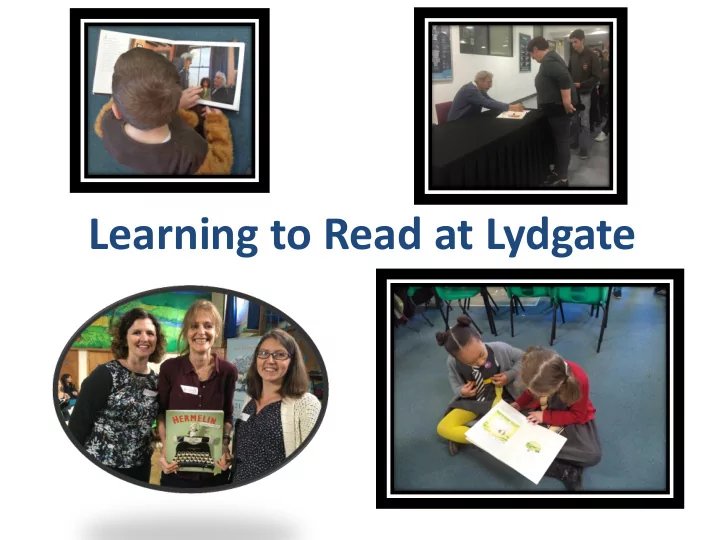

Learning to Read at Lydgate
What is reading? Word- Compre reading hension (skill) (skill) Motivation (experiences)
Comprehension In Foundation/Reception we teach reading by… • Teaching children graphemes (letters) in phonics • Getting children to apply these phonic (or word-reading) skills in the books they read • Reading stories to the children and talking about them (as a whole class, in a small group) • Getting the children to talk about the books they read to us (either 1:1 or within a small group) • Giving the children opportunities to play in ways which involve stories – to explore ideas from stories through their play and, later, their writing.
What are Book Bands? Why are Book Bands? Children are on a particular book band because of their COMBINED word-reading and comprehension skills. We assess the children throughout the year to see how they are progressing in their reading. This is an informal and ongoing process.
PINK Book Band To move to the next band (RED), children will • … retell what has happened so far • … predict what might happen next based on their understanding of this and other texts • … be working within Phonics Phase 2, with a secure knowledge of most single-letter graphemes • …segment and blend any CVC word independently • … read these TRICKY words: I, go, into, no, the
Learning to read – the early stages Step One: Understand that words are separate from each other.
Learning to Read: the early stages Step Two: Books with simple repetitive text where one word changes. My Dad has socks. My Dad has a jumper. My Dad has a hat. My Dad has no shoes! Are they using phonics to read the changed words?
Learning to Read: the early stages Step Three: Apply phonics to read simple texts which need the child to apply the phonics they already know.
RED To move to the next band (YELLOW), children will • … retell what has happened in a story/explain what an information text is about • … predict what will happen next based on their understanding of this and other texts • … describe how characters are feeling, beginning to base their opinions on evidence in the text • … begin to hear when their reading doesn’t make sense • … have a secure knowledge of all Phase 2 graphemes and be able to apply them as they read (s, a, t, p, i, n, o, c, k etc) … have started to apply some phonic Phase 3 digraphs in their reading ( sh, ch, th, ng, ck, ee, oo) … be able to read these TRICKY words: he she we me be was my you her they all are • … read with >95% accuracy most red -banded texts • … read RED texts with fluency
How you can support your child at home • 3 – 5 times a week. • Short, regular, positive reading sessions. • Supportive reading experiences: not a test (take it in turns; talk; games; time-limits etc) • Get your child to apply their phonics as they read. • Activating background knowledge: Tell them names of characters/places; identify sounds they’re going to meet; make links with own experiences. • DO pay attention to your child’s understanding. • DO communicate with us – this is a partnership. • DON’T struggle alone, we’re here to support you.
School Books at Home Where are the books in school? How often should I aim to get my child to read to me? How often should I change the book?
Reading to children and talking about the books we read will build their understanding of the sentence structures and vocabulary we are more likely to come across in reading.
EYFS & KS1 Children gain a sense of mastery from being able to read texts independently, a sense of ‘I can do this!’ which is so important in motivating them to read. However, the down sides of a carefully controlled vocabulary include limitations to the richness of the story, which might have negative effects on motivation. This can and should be counteracted by making sure we read to and with the children those rich and rewarding stories that are as yet beyond their own capacity to read, but not beyond their capacity to understand and enjoy, given the opportunity.
Motivation • Reading to our children motivates them to persevere themselves • Texts they enjoy (including re-reading texts) • Permission – book corners at school and book- boxes/shelves at home
How we teach reading at school • Phonics (Letters and Sounds) • Guided Reading • Storytime • English lessons • 1:1 reading • Library visits • Home/School Reading diary
Reading is… … a gift every child has a right to … a door onto a world of experiences and information beyond the child’s own experience … not always easy – but we can get every child there
Recommend
More recommend